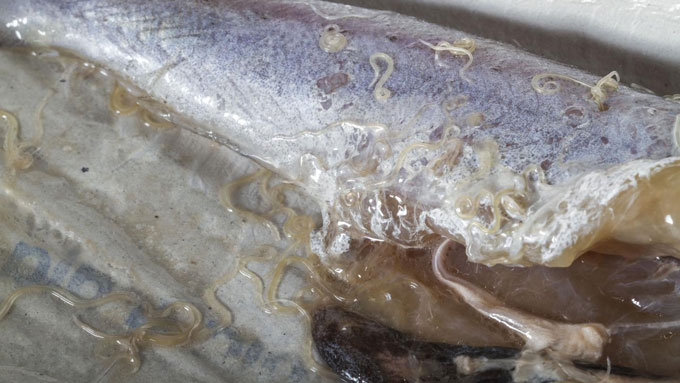“Waiter, there’s a worm in my sushi.”
Diners may be more likely to utter those words today than in decades past, as the abundance of parasitic Anisakis worms infecting fishes around the globe is now 283 times what it was in the 1970s, researchers report March 19 in Global Change Biology.
Worms of the genus Anisakis, also called whale worms, can cause vomiting and diarrhea in people who ingest them. Fortunately, freezing fillets kills the parasites, and farmed fish are rarely infected with them. Sushi chefs and other fish suppliers can spot and remove the worms, which can reach up to 2 centimeters in length. But the rise in worm numbers might spell bad news for some marine animals.
Researchers analyzed hundreds of global scientific studies published since 1967 to assess the number of worms — both Anisakis and a related genus called Pseudoterranova — per individual fish. Overall, the data included more than 55,000 specimens of 215 fish species.
In 1978, the first year for which the researchers had sufficient data for both worm groups, scientists reported finding less than one whale worm on average per 100 fish. By 2015, they were finding more than one Anisakis worm on average per individual fish. The trend held true across fish species and geographic regions, and regardless of the methods used to quantify worms, which ranged from simple dissection to dissolving fish tissues with acid. However, there was no global increase in reports of Pseudoterranova, also known as seal worms.
 This blue whiting fish is crawling with Anisakis worms. In the 1970s, the parasites were found in fewer than 1 in 100 fish. Now the average is more than one parasite per individual fish, so though some fish may have none, others may have many.Gonzalo Jara/Shutterstock
This blue whiting fish is crawling with Anisakis worms. In the 1970s, the parasites were found in fewer than 1 in 100 fish. Now the average is more than one parasite per individual fish, so though some fish may have none, others may have many.Gonzalo Jara/Shutterstock
That increase in Anisakis could be a problem for the wrigglers’ diverse hosts: The worms’ eggs can be taken up by krill, which are eaten by cephalopods like squid, which are ingested by fishes. All of these are gobbled up by whales and dolphins.
Populations of any of those hosts could be at risk when Anisakis abundance is high, and the results aren’t pretty. For example, whale worms infecting Atlantic salmon can cause red vent syndrome, with swelling and bleeding of the opening to the digestive and reproductive tract. The worms are often found in whale autopsies, though it’s unclear how ill infected animals might become, says study coauthor Chelsea Wood, a parasite ecologist at the University of Washington in Seattle.
The fact that Anisakis worms appear to be increasingly common could imply that host species are abundant enough to support a booming parasite population, Wood says. If populations of a host species were dwindling, the worms would struggle to complete their life cycle. Instead, “these worms might be a signal that things are getting better for ocean ecosystems,” she says.
For instance, the rise in Anisakis may be due to the fact that some whale populations are rebounding (SN: 11/18/19). Those marine mammals play a crucial role in the worms’ life cycle: Anisakis reproduce only in cetaceans. Wood’s earliest data points date to before the International Whaling Commission’s moratorium on commercial whaling went into effect in 1986, though a few nations persist in the hunt.
Another possible, though hypothetical, explanation for the parasites’ abundance is that the parasites’ life cycles might be speeding up as ocean waters warm due to climate change.
Wood’s team is now studying museum fish specimens that go further back in time to determine whether today’s worm populations are a sign of longer-term environmental decline, or rebound from human damage to the ocean and its inhabitants.
“My gut feeling is that it’s about recovery to a prehuman baseline,” Wood says. “In a pristine ocean, there were tons of marine mammals pooping out lots of Anisakis that infected fish in great abundance.”
The team is also investigating what such a high parasite load might mean for those marine mammals, focusing on a struggling killer whales population off the U.S. West Coast. “We don’t have a lot of information about what the effects are,” Wood says.
Fish parasitologist Kurt Buchmann says Wood’s results match his own observations. “It is my general impression that the occurrence ofAnisakis has, in fact, increased, at least in some waters,” says Buchmann of the University of Copenhagen. But while the new meta-analysis reports global worm population averages, parasite patterns can vary locally, Buchmann notes. In the Baltic Sea, for example, Buchmann has seen a dramatic rise in seal worms along with their host, gray seals, even though the new study finds no change in overall seal worm abundance.
Despite the study results, Wood hasn’t lost her taste for a nice fish fillet. She’s confident that preparers will pick out the worms, and sushi chefs outperform even scientists in spotting them, she says. “I still eat sushi.”
Source: Heart - www.sciencenews.org



